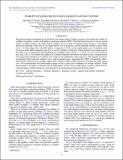| dc.contributor.author | Payne, Matthew J. | |
| dc.contributor.author | Deck, Katherine M. | |
| dc.contributor.author | Holman, Matthew J. | |
| dc.contributor.author | Perets, Hagai B. | |
| dc.date.accessioned | 2015-02-03T16:33:23Z | |
| dc.date.available | 2015-02-03T16:33:23Z | |
| dc.date.issued | 2013-09 | |
| dc.date.submitted | 2013-08 | |
| dc.identifier.issn | 2041-8205 | |
| dc.identifier.issn | 2041-8213 | |
| dc.identifier.uri | http://hdl.handle.net/1721.1/93729 | |
| dc.description.abstract | We perform numerical integrations of four-body (star, planet, planet, satellite) systems to investigate the stability of satellites in planetary systems with tightly packed inner planets (STIPs). We find that the majority of closely spaced stable two-planet systems can stably support satellites across a range of parameter-space which is only slightly decreased compared to that seen for the single-planet case. In particular, circular prograde satellites remain stable out to ~0.4 R[subscript H] (where R[subscript H] is the Hill radius) as opposed to 0.5 R[subscript H] in the single-planet case. A similarly small restriction in the stable parameter-space for retrograde satellites is observed, where planetary close approaches in the range 2.5-4.5 mutual Hill radii destabilize most satellites orbits only if a ~ 0.65 R[subscript H]. In very close planetary pairs (e.g., the 12:11 resonance) the addition of a satellite frequently destabilizes the entire system, causing extreme close approaches and the loss of satellites over a range of circumplanetary semi-major axes. The majority of systems investigated stably harbored satellites over a wide parameter-space, suggesting that STIPs can generally offer a dynamically stable home for satellites, albeit with a slightly smaller stable parameter-space than the single-planet case. As we demonstrate that multi-planet systems are not a priori poor candidates for hosting satellites, future measurements of satellite occurrence rates in multi-planet systems versus single-planet systems could be used to constrain either satellite formation or past periods of strong dynamical interaction between planets. | en_US |
| dc.description.sponsorship | United States. National Aeronautics and Space Administration (Origins of Solar Systems Program Grant NNX13A124G) | en_US |
| dc.description.sponsorship | United States-Israel Binational Science Foundation (Grant 2012384) | en_US |
| dc.description.sponsorship | National Science Foundation (U.S.). Graduate Research Fellowship | en_US |
| dc.language.iso | en_US | |
| dc.publisher | IOP Publishing | en_US |
| dc.relation.isversionof | http://dx.doi.org/10.1088/2041-8205/775/2/l44 | en_US |
| dc.rights | Article is made available in accordance with the publisher's policy and may be subject to US copyright law. Please refer to the publisher's site for terms of use. | en_US |
| dc.source | American Astronomical Society | en_US |
| dc.title | STABILITY OF SATELLITES IN CLOSELY PACKED PLANETARY SYSTEMS | en_US |
| dc.type | Article | en_US |
| dc.identifier.citation | Payne, Matthew J., Katherine M. Deck, Matthew J. Holman, and Hagai B. Perets. “STABILITY OF SATELLITES IN CLOSELY PACKED PLANETARY SYSTEMS.” The Astrophysical Journal 775, no. 2 (September 18, 2013): L44. © 2013 The American Astronomical Society | en_US |
| dc.contributor.department | Massachusetts Institute of Technology. Department of Physics | en_US |
| dc.contributor.department | MIT Kavli Institute for Astrophysics and Space Research | en_US |
| dc.contributor.mitauthor | Deck, Katherine M. | en_US |
| dc.relation.journal | The Astrophysical Journal. Letters | en_US |
| dc.eprint.version | Final published version | en_US |
| dc.type.uri | http://purl.org/eprint/type/JournalArticle | en_US |
| eprint.status | http://purl.org/eprint/status/PeerReviewed | en_US |
| dspace.orderedauthors | Payne, Matthew J.; Deck, Katherine M.; Holman, Matthew J.; Perets, Hagai B. | en_US |
| mit.license | PUBLISHER_POLICY | en_US |
| mit.metadata.status | Complete | |
